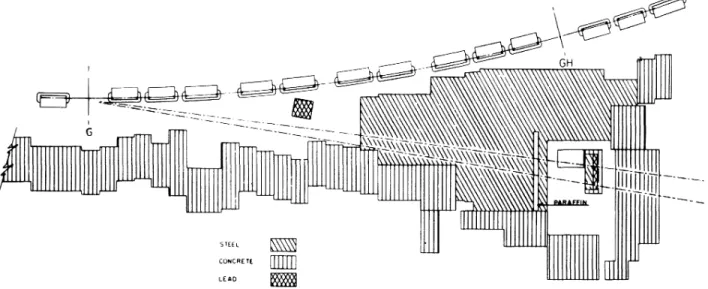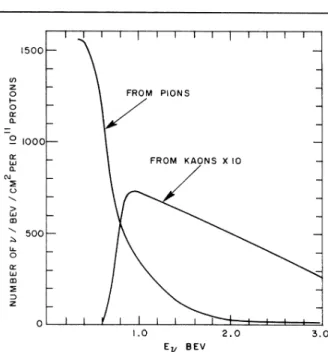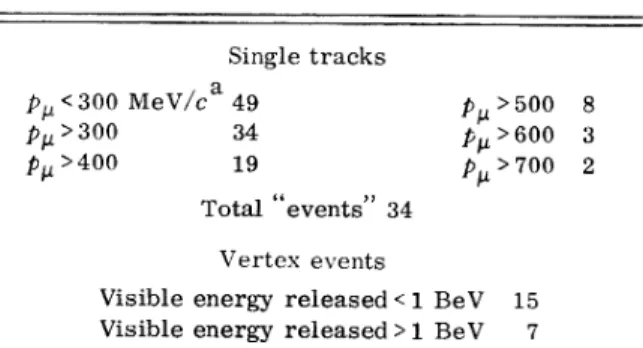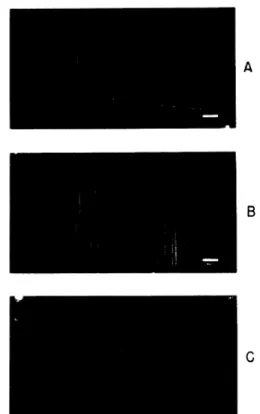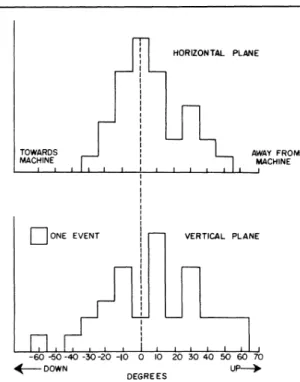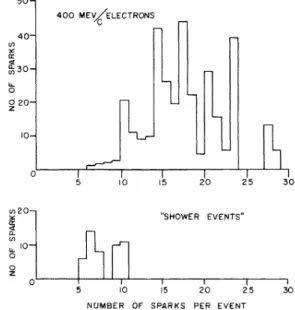VoLUME 9,NUMBER 1
PHYSICAL REVI EW LETTERS
JULY l, 1962 The latter events can be observed only indirectlybecause neither the K,
'
nor the neutronis
seen.Figure 2(c) shows the "missing
mass"
spectrum for events which have a K,'
as the only visiblecollision product. The events in the KN region of phase space must be corrected for contamina- tion from K,
'K,
'n, &'K'A', ~'K'Z finalstates.
This was easily done at
1.
89 BeV/c since all these reactions have been studied in apreviousexperi-
ment at that momentum. The result shows there were
(17+
8)K,'K,
'n events and(15+
7) K K'p events, which compares favorabl. y with the equal number called for by the one-pion-exchange model.Provided the one-pion-exchange model is valid, one may place rather
strict
limits on the angular momentum of the KK system. Since the G parity ofthe wv system is even, wehave"
G=(-1)
=+1,
whereI is
the angular momentum of the KK system andI is
the isotopic spin. The data inFig.
2(a) then suggest the low-energycross
section for vm KKis-2
mb forI =0, I =0
Kpairs and
-0.
6 mb forI=1,
1.=1
Kpairs.
Bothcross
sections drop to low values for energies of 100MeVor
more above threshold for the KKsys-
tem.Eight examples of K+K production [reaction (3) j observed in this experiment were not included in the foregoing analysis. The signature ofthese events is a charged K+ decay, which
is
sensitive to the K momentum spectrum. Additional bias may result from the difficulty in distinguishing some ofthese events from Z+ decays. In oursample of eight events the K+K masses occur in the lower half of phase space in a manner
sim-
ilar to reaction (1), but therecoil
nucleon tends to go forward. This latter observation may indi- cate that not all K pairs are produced in periph-eral
collisions.We would like to thank
Dr. R.
G. Sachs,Dr.
C.Goebel, and
Dr.
Mare Ross for helpfuldiscus-
sions concerning this data. We are grateful toJ.
Boyd andS. S.
Lee for their help withcalcu-
lations and preparation ofthe data.*Work supported in part by the U.
S.
Atomic Energy Commission and the Wisconsin Alumni Research Foun- dation.M. Baker and
F.
Zachariasen, Phys. Rev. 119,438 (1960).
Mao-Chen, Phys. Rev. 125, 2125(1962).
G. Costa and
L.
Tenaglia (to be published).Proceedings ofthe Aix-en-Provence Conference on Elementary Particles, 1961
{C. E.
N. Saclay, France, 1961),Vol.1, p. 101.
G.
F.
Chew andF. E.
Low, Phys. Rev. 113,1640 (1959).F.
Salzman and G. Salzman, Phys. Rev. 120, 599 (1960).
~A.
R.
Erwin,R.
H. March, W. D.Walker, andE.
West, Phys. Rev. Letters
6,
628 (1961).M. Goldhaber,
T.
D. Lee, andC.
N. Yang, Phys.Rev. 112, 1796 (1958)
.
A.
R.
Erwin,R.
H. March, and W. D.Walker, Nu- ovo cimento 24, 237 (1962).We have assumed throughout that the intrinsic KK parity product is even.
OBSERVATION OFHIGH-ENERGY NEUTRINO REACTIONS AND THE EXISTENCE OF TWO KINDS OF NEUTRINOS
G. Danby,
J-M.
Gaillard,K
Goulianos,L.
M. Lederman, N. Mistry, M. Schwartz, 't and Z. SteinbergertColumbia University, New York, New York and Brookhaven National Laboratory, Upton, New York (Received June 15, 1962)
In the course of an experiment at the
Brook-
haven AGS, we have observed the interaction ofhigh -energy neutrinos with matter. These neutrinos were produced primarily
as
the result of the decay of the pion:m+ p~ +(v/v).
It
is
the purpose of this Letter to report some of the results ofthis experiment including (1) dem- onstration that the neutrinos we have usedpro-
duce p. mesons but do not produce electrons, and hence are very likely different from the neutrinos involved in Pdecay and (2) approximate
cross
sections.Behavior of
cross
sectionas
a function of en- ergy. The Fermi theory of weak interactions which works well at lom energies implies across
section for weak interactions which increases as phase space. Calculation indicates that weak in- teractingcross
sections should be in the neigh-VOLUME 9,NUM~
PHYSICAL
RE
VIEWLETTERS
Jt'I.Y 1, 1962 borhood of 10"
cm'cm' at about 1BeV. Iang
first
calculated fore e detailed
cross
sectionV+yg
~P+e
'PV+/ ~yg+e V+g
~P
+P. 7V+P ~Pg+ P,
us1'ng the vector form f
t
(3)
tron scatterin
ac or
deduced fromelec-
ing results and assum' vector form fact
ssuming the axia,l m
actor
to be the sameform
factor.
Subarne
as
the vectoru sequent work has b Yamaguchi' and C bb'
as
een done by culations have ba ibo and Gatto.
o. '
Thesecal-
e een used
as
stan wi experiments.Unitarit y annd the absence of the de A major diffic lt' u y of the Fermi th
o e decay p.
~e+y.
energies
is
them1theory at high enecessity tha,
t
itbr
fore the
cross
set'
reak downbe- ss
section reaches m~'unitarity. This b
, violating 300 BeV ' th
is
reakdown must occur below 1n e center of mass. T 'i e i an intermediat a interactions.
F
' b 4 Ing ratio (p.e+
)j(
mpl1es a branch-
10,
unless the1
~e+y
P,~e+
V+Vv) ofthe order ofss
e neutrinosassoci
are
different from thoc1ated with muons trons.5
I.
ee and Yarom those associated w1th
elec-
n ang have subse a mechanism which serve unitarit y shs ould lead to a
ic ~e+
would
pre-
ot tooo d'ff1 erent from the
h th branchingh' g ratio'o ' d to b e ypothesis that thee
t
wo neutrinos maybe different has found some favor. p
is
on y onet
ype o' o 1neractions should rod
~
o p o
in equal abundance. In wo neutrinos, there
is
ec rons at all.
The feasibility of d ' n
at
accelerators
o oing neutrinno experiments
ors
was proposed indeP
t
d 8 h ~M n chwartz.
'
It wastors
neu rinos available fromm a
accelera-
uce o the order of ons of
detector.
The essential scheme of the ex
eri
f llo ' At
''b
f:
u r1no"beam" is
* o pions accordin to The pions
are
rodg o reaction
(1).
EI
t
to t, k 13oving in the general dir
t
d't
of 21i
es
a13.
5-m thickir
o m from the
tar
1nteractionsare
br
get. Neutr ino e o served ina 10-t
spark chamber l
-ton aluminum
r
ocated behind th The line offl h1s shield.
1g
t
ofthe beam f detector makem rom target to
es
an angle of 75' t
ro on direction (see
Fi
the muons penetratin theo BeV
is
cho level.ne rating the shield to atolerable The number and energ s e
from
rea c t
1on 1 can be ra.therrgy spectrum of neutr lnos on the
basis
ofe ra.ther well calculated o measured pion-
r
and the geometr
-production
rates"
from m deca
is
e
ry.
The expect
ed neutrino flux cayis
shown in Fig. 2. Aiso shownis
6
(--'
i II 1
LE+0
FIG.
1.
Plan view ofAGS neutneutrino experiment.VOLUME 9,NUMBER I
PHYSICAL REVIEW LETTERS
JULY I, 1962I500—
I l I I I I I I
ZO I-0
Q Q
—1000—
fL
ELI Q.
NX
CD
0
LLI
m
500—
tLO
4J m
0 I,O
Ep BEV
2.0 3.0
FIG. 2. Energy spectrum ofneutrinos expected in the arrangement of Fig. 1for 15-BeVprotons on
Be.
an estimate of neutrinos from the decay K jL(,
+v(v). Various checks were performed to com- pare the targeting efficiency (fraction of
circulat-
ing beam that interacts in the target) during the neutrino run with the efficiency during the beam survey run. (We believe this efficiency tobe close to 70%.) The pion-neutrino flux
is
con- sidered reliable to approximately 30%down to 300MeV/c, but the flux below this momentum does not contribute to the results we wish to present.The main shielding wall thickness,
13.
5 m for most of the run, absorbs strongly interacting particles by nuclear interaction and muons upto 17 BeV by ionization
loss.
The absorption mean free path in iron for pions of3,
6, and 9BeVhas been measured to beless
than0.
24m.
"
Thus the shield provides an attenuationof the order of 10 '4 for strongly interacting
particles.
This attenuationis
more than suf- ficient to reduce these particles to a level com- patible with this experiment. The background of strongly interacting particles within thede- tector
shield probably enters through the con-crete
floor and roof of the 5.5-m thick side wall.Indications of such leaks were, in fact, obtained during the early phases of the experiment and the shielding subsequently improved. The argu- ment that our observations
are
not induced by strongly interacting particles will also be made on thebasis
of the detailed structure ofthe data.Bg
~C
YXXXW//+~&//g~~XXX ~&XZg
FIG.
3.
Spark chamber and counter arrangement.A are the triggering slabs;
B,
C, and D are anticoinci- dence slabs. This is the front view seen by the four- camera stereo system.The spark chamber detector consists of an
ar-
ray of 10one-ton modules. Each unit has 9alu- minum plates 44 in.@44 in.&1 in. thick, sepa- rated by -,-in. Lucite
spacers.
Each moduleis
driven by a specially designed high-pressure spark gap and the entire assembly triggeredas
described below. The chamber will be more fully described elsewhere. Figure 3 illustrates the arrangement of coincidence and anticoinci- dence counters. Top, back, and front anticoinci- dence sheets (a total of 50 counters, each 48 in.xll
in. x-,'in. )
are
provided to reduce the effect of cosmic rays and AGS-produced muons which penetrate the shield. The top slabis
shielded against neutrino events by 6 in. of steel and the back slab by 3 ft of steel and lead.Triggering counters were inserted between adjacent chambers and at the end (see Fig.
3).
These consist ofpairs of counters, 48 in.
F11
in.&-,
'
in., separated by —,
'
in. of aluminum, and infast coincidence. Four such pairs cover a cham-
ber;
40are
employed in all.The AGS at 15 BeV operates with
a
repetition period of1.
2sec.
A rapid beam deflector drives the protons onto the3-in.
thickBe
target over a period of20-30
p,sec.
The radiation during this interval hasrf
structure, the individual bursts being 20 nsec wide, the separation 220nsec.
This structureis
employed to reduce the total"on"
time and thus minimizecosmic-
ray background. A Cerenkov counter exposedVOLUME 9,NUMBER 1 PH
YSI CAL RE
VIE%' LETTERS
JUT.V 1, 1962 to the pions in the neutrino"beam"
provides atrain of
30-nsec
gates, whichis
placed inco-
incidence with the triggering events. The
cor- rect
phasingis
verified by raising the machine energy to 25 BeVand counting the high-energy muons which now penetrate the shield. The tight timing also serves the useful function of reducing sensitivity to low-energy neutrons which diffuse into the detector room. The trigger con-sists
ofa fast twofold coincidence in any of the 40 coincidence pairs in anticoincidence with the anticoincidence shield. Typical operation yields about 10 triggers per hour. Half the photographsare
blank, the remainder consist of AGS muons entering unprotectedfaces
ofthe chamber, cosmic rays, and "events."
In order to verify theoper-
ation of
circuits
and the gap efficiency of the chamber,cosmic-ray test
runsare
conducted every four hours. These consist oftriggering on almost horizontalcosmic-ray
muons andre-
cording the results both on film and on Land prints for rapid inspection (see Fig.
4).
A convenient monitor for this experiment
is
the number of circulating protons in the AGS machine.Typically, the AGS operates at a level of
2-4x10"
protons per pulse, and 3000pulses per hour. In an exposure of
3.
48~10'
protons, we have counted113
events satisfying the following geometriccriteria:
The event originates within afiducial volume whose boundaries lie 4 in. from the front and back walls of the chamber and 2 in. from the top and bottom walls. Thefirst
two gaps must notfire,
in order to exclude events whose origins lie outside the chambers. In addition, in thecase
ofevents consisting ofa singletrack,
an extrapo- lation of thetrack
backwards (towards the neu- trino source) for two gaps must also remain with- in the fiducial volume. The production angle of these singletracks
relative to the neutrino line of flight must beless
than60'.
These
113
events may be classified furtheras
follows:(a) 49 short single
tracks.
These are singletracks
whose visible momentum, if interpreted as muons, isless
than 300 MeV/c. Thesepre-
sumably include some energetic muons which leave the chamber. They also include low-ener- gy neutrino events and the bulk of the neutron produced background. Of these,
19
have 4 sparks orless.
The second half of the run(1.7x10'~
protons) with improved shielding yielded only three
tracks
in this category. We will not con- sider theseas
acceptable "events."
(b) 34 "single muons" of more than 300 MeV/c.
These include
tracks
which, if interpretedas
muons, have a visible range in the chambers such that their momentumis
at least 300MeV/c.The origin ofthese events must not be
accom-
panied by more than two extraneous sparks. The latter requirement means that we include among
"single
tracks"
events showing a smallrecoil.
The 34 events
are
tabulatedas
afunction of momentum in TableI.
Figure 5 illustrates 3"single muon" events.
(c)22
"vertex"
events. A vertex eventis
one whose originis
characterized by more than onetrack.
All ofthese events show a substantial energyrelease.
Figure 6 illustrates some of these.(d) 6 "showers.
"
Theseare
all the remaining events. Theyare
in general singletracks,
too irregular in structure to be typical of p, mesons, and more typical of electron or photon showers.From these 8 "showers,
"
for purposes of com-pa.rison with (b), we may
select
a group of 6 which are so located that their potential range within the chamber corresponds to p. mesons inexcess
of 300 MeV/c.In the following, only the 56 energetic events oftype (b) (long p.
's)
and type (c) (vertex events) will bereferred
toas
"events."
Arguments on the neutrino origin of the ob-
Table
I.
Classification of events.Single tracks
p„&
300MeV/ca49p~ &300 34 p~ &400 19
Total events 34 Vertex events
p &500 8 pp &600 3 p &700 2
FEG.
4.
Land print ofCosmic-ray muons integrated over many incoming tracks.Visible energy released &1BeV 15 Visible energy released &1BeV 7
a CC
These are not included in the event count (see text).
VoLUME 9,NUMBER 1
PHYSICAL REVIEW LETTERS
JUL+' 1, 1962FIG.
5.
Single muon events. (A) p &540 MeV and 5 ray indicating direction of motion (neutrino beam in- cident from left); (B)p&&700MeV/c; (C) p &440with 6 ray.FIG.
6.
Vertex events. (A) Single muon ofp&&500 MeV and electron-type track; (B) possible example of two muons, both leave chamber; (C) four prong star with one long track ofp„&600
MeV/c.served "events.
"
1.
The"events" are
not produced by cosmicrays.
Muons from cosmic rays which stop in the chamber can and do simulate neutrino events.This background
is
measured experimentally by running with the AGS machine off on the same triggering arrangement except for the Cerenkov gating requirement. The actual triggeringrate
then
rises
from 10 per hour to 80 per second (a dead-time circuit prevents jamming of the spark chamber). In 1800cosmic-ray
photographs thus obtained, 21 would be acceptedas
neutrino events. Thus 1 in 90cosmic-ray
eventsis
neu- trino-like. Cerenkov gating and the short AGS pulse effect a reduction by a factor of-10 '
since the
circuits are "on"
for only3.
5 jL(.sec
per pulse. In fact, for the body of datarepre-
sented by TableI,
atotal of1. 6&10
pulses were counted. The equipment was therefore sensitive for a total time of 5.5sec.
This should lead to 5.5x80=440 cosmic -raytracks
whichis
consistent with observation. Among these, there should be5+1 cosmic-ray
induced *'events."
These
are
almost evident in the small asym-metry seen in the angular distributions of Fig.
7. The remaining 51 events cannot be the result ofcosmic
rays.
2.
The"events" are
not neutron produced.Several observations contribute to this con- clusion.
(a) The origins of all the observed events are uniformly distributed over the fiduciary volume, with the obvious bias against the last chamber induced by the p&
)
300MeV/c requirement.Thus there
is
no evidence for attenuation,al-
though the mean
free
path for nuclearinter-
action in aluminumis
40 cm and forelectro-
magnetic interaction 9 cm.(b) The front iron shield
is
so thick that we can expectless
than10~
neutron induced reactions in the entire run from neutrons which have pen- etrated this shield. This was checked byre-
moving 4ft of iron from the front of the thick shield. Ifour events were due to neutrons in line with the target, the event rate would have increased by a factor ofone hundred. No such effect was observed (see Table
II).
Ifneutrons penetrate the shield, it must be from otherdi-
40VOLUME 9,NUMBER 1
PHYSI CAL REVIEW LETTERS
JULY l, 1962HORIZON TAL PLANE
TOWARDS I
MACHINE f I
I
I I I t
AWAY FRONI MACHINE
I I
ONE EVENT VERTICAL PlANE'
I l I I I I I I I l I
-60 %0-40-R)-20-IO 0 IO 20 30 40 50 6070
DOWN UP
DEGREES
FIG. 7. Projected angular distributions of single track events. Zero degree is defined as the neutrino direction.
Table II. Event rates for normal and background conditions.
Circulating No.of Calculated Net rate protons &108 Events cosmic-ray per 10
contribution Normal run 34.8
Background I
3.
0 Background II 8.65
0.5
1.
51.
460.
50.3 a
b4 ft of Fe removed from main shielding wall.
As above, but 4ftof Pb placed within 6ft ofBetar- get and subtending ahorizontal angular interval from 4 to
ll'
with respect to the internal proton beam.These should be subtracted from the single muon category.
rections.
The secondaries wouldreflect
this directionality. The observed angular distribution of singletrack
eventsis
shown in Fig.7.
Except for the smallcosmic-ray
contribution to thever- tical
plane projection, both projectionsare
peaked about the line of flight to thetarget.
(c) If our 29 single
track
events (excludingcos-
mic-ray background) were pions produced by neutrons, we would have expected, on thebasis
ofknown productioncross
sections, ofthe order of 15single m"s to have been produced. Nocases
of unaccompanied m's
have been observed.3.
The singleparticles
produced show littleor
no nuclear interaction and
are
therefore presumed to be muons.For
the purpose ofthis argument, itis
convenient tofirst
discuss the second half of our data, obtained after some shielding im- provements were effected. A totaltraversal
of 820 cm of aluminum by singletracks
was ob- served, but no"clear" case
ofnuclearinter-
action suchas
large angle or charge exchange scattering was seen. In a spark chambercali-
bration experiment at the Cosmotron, it was found that for 400-MeV pions the mean
free
path for"clear"
nuclear interactions in the chamber (as distinguished from stoppings) is no more than 100cm ofaluminum. We Should, therefore, have observed of the order of 8"clear" inter-
actions; instead we observed none. The meanfree
path for the observed singletracks is
then more than 8times the nuclear meanfree
path.Included in the count
are
5tracks
which stop in the chamber. Certainly a fraction of the neutrino secondaries must be expected tobe produced with such small momentum that they would stop in the chamber. Thus, none ofthese stoppings may, infact,
be nuclear interactions.But even if all stopping
tracks are
considered to represent nuclear interactions, the meanfree
path of the observed singletracks
must be 4 nuclear meanfree
paths.The situation in the
case
oftheearlier
datais
more complicated. We suspect that a fair fraction of the short singletracks
then observedare,
infact,
protons produced in neutron collisions.However, similar arguments can be made also for these data which convince us that the energetic single
track
events observed thenare
also non- interacting.'
It
is
concluded that the observed singletrack
eventsare
muons, as expected from neutrino interactions.4.
The observed reactionsare
due to the decay products of pions and K mesons. In a second background run, 4 ft of iron were removed from the main shield and replaced by a similar quanti- ty of lead placedas close
to the targetas feasi-
ble. Thus, the detector views the target through the same number of meanfree
paths of shielding material. However, the path available for pions to decayis
reduced by a factor of8.
Thisis
theclosest
we could come to "turningoff"
the neu- trinos. The results of this runare
given in terms of the number of events per10' circulat-
ing protons in Table
II.
The rate of"events" is
reduced from1.
46+0.
2 to0. 3+ 0.
2 per 10'6in-
VOLUME 9,NUMBER I
PHYSICAL REVIEW LETTERS
JULY 1,1962cident protons. This reduction
is
consistent with that whichis
expected for neutrinos whichare
the decay products of pions and K mesons.Are there two kinds ofneutrinos? The
earlier
discussion leads us to ask if the reactions (2) and (3) occur with the samerate.
This would be expected ifv,
the neutrino coupled to themuon and produced in pion decay,
is
the sameas
ve, the neutrino coupled to the electron and produced in nuclear beta decay.%e
discuss only the singletrack
events where the distinction between single muontracks
ofP &300 MeV/c and showers produced by high-energy single electronsis clear.
SeeFigs.
8 and 4 whichil-
lustrate this difference.
%'e have observed 34 single muon events of which 5
are
considered to becosmic-ray back-
ground. If v =
v,
there should be of the orderof 29electron showers with a mean energy greater than 400 MeV/c. Instead, the only candidates which we have for such events
are
six"showers"
of qualitatively different appear- ance from those of Fig.8.
To argue morepre-
cisely, we have exposed two of our one-ton spark chamber modules to electron beams at the Cosmotron. Runs were taken at various electron energies. From these we establish that thetrig-
gering efficiency for 400-MeV electrons
is
67%.As a quantity
characteristic
of the calibration showers, we have taken the total number of ob- served sparks. The mean numberis
roughly linear with electron energy up to 400 MeV/c.Larger showers saturate the two chambers 50-
40
V) IL Q.30
400MEV ELECTRONS C
which were available. The spark distribution for 400 MeV/c showers
is
plotted in Fig. 9, normalized tothegx29
expected showers. The six "shower" eventsare
also plotted.It is evi-
dent that these
are
not consistent with thepre-
diction based on a universal theory with v&=ve.
It can perhaps be argued that the absence of electron events could be understood in terms of the coupling of a single neutrino to the electron which
is
much weaker than that to the muon at higher momentumtransfers,
although at lower momentumtransfers
the results ofP decay, capture, p, decay, and the ratio ofm~
p,+vton
~ e+
vdecay show that these couplingsare
equal."
However, the most plausible explana- tion for the absence of the electron showers, and the only one which preserves universality,is
then thatv„g v,
'i. e.
, that thereare
at least two types of neutrinos. This also resolves the problem raised by the forbiddenness of thep,+
~e++y
decay.It remains to understand the nature of the 6
"shower" events. All of these events were ob- tained in the
first
part of the run during conditions in which there was certainly some neutronback-
ground. Itis
not unlikely that some of the eventsare
small neutron producedstars.
One or two could, in fact, be p. mesons. It should also be remarked that of the order of one or twoelec-
tron eventsare
expected from the neutrinos produced in the decays K~e
+v+~'
andO20-
IO-
l IO
20t 30I
m20—
hC CL CL
~ IO—
0
'SHOWER EVENTS'
I IO
I I
20 25
FIG. 8. 400-MeV electrons from the Cosmotron.
NUMBER OF SPARKS PER EVENT
FIG.
9.
Spark distribution for 400-MeVjc
electronsnormalized to expected number ofshowers. Also shown
are the shower events.
goy,UME 9,NUMBER 1
PHYSICAL REVIEW LETTERS
JUr.v 1,1962K
'~p~+
v +n~.2 8
The intermediate boson. It has been pointed out' that high-energy neutrinos should serve
as
a reasonable method of investigating theexist-
ence of an intermediate boson in the weakinter-
actions. In recent years many of the objections to such a particle have been removed by the advent of V-A theory' and the remeasurement of the p value in p, decay."
The remainingdif-
ficulty pointed out by Feinberg, 4 namely theab-
sence of the decay p.~e+y, is
removed by the results ofthis experiment. Consequently itis
ofinterest to explore the extent to which our experiment has been sensitive to the production ofthese bosons.Our neutrino intensity, in particular that part contributed by the K-meson decays,
is
sufficient to have produced intermediate bosons if the boson had a mass m~less
than that of the mass of the proton (mp). In particular, ifthe boson had a mass equal to0.
6m~, we should have produced-20
bosons by theprocess
v+p Ml++ p.+p.
Ifm, =m,
then we should have observed 2 such events.'
Indeed, of our vertex events, 5
are
consistent with the production ofaboson. Two events, with two outgoing prongs, one of whichis
shown inFig. 6(B), are
consistent with both prongs being muons. This could correspond to the decay modeM+
~
p,++
v. One event shows four outgoingtracks,
each ofwhich leaves the chamber after traveling through 9 in. of aluminum. This might in prin- ciple be an example ofM)+~a++~ +m+. Another event, by far our most spectacular one, can be interpretedas
having a muon, a charged pion, and two gamma rays presumably from a neutral pion. Over 2 BeVof energyrelease is
seen in the chamber. This could in principle be anex-
ample of ~(' ~m +m'. Finally, we have one event, Fig. 6(A), in which both a.muon and an electron appear to leave the same vertex. If this were a boson production, it would correspond to the boson decay mode se
~e
+ v. The alternative explanation for this event would require (i) that aneutral pion be produced with the muon; and (ii) that one of its gamma rays convert in the plate of the interaction while the other notcon-
vert visibly in the chamber.The difficulty of demonstrating the existence ofa boson
is
inherent in the poor resolution of the chamber. Future experiments should shed more light on this interesting question.Neutrino
cross
sections.%e
have attempted to compare our observations with the predictedcross
sections for reactions (2) using the theory.'
3To include the fact that the nucleons in (2)
are,
in
fact,
part of an aluminum nucleus, a Monte Carlo calculation was performed using asimple Fermi model for the nucleus in order to evaluate the effect of the Pauli principle and nucleon mo- tion. This was then used to predict the number of"elastic"
neutrino events to be expected under our conditions. The results agree with simpler calculations based on Fig. 2 to give, in terms of number of circulating protons,from m
~
p.+v,fromK~p, +v, Total
0.
60events/10"
protons,0. 15 events/10"
protons,0.
75events/10"
+-30%%ug.The observed
rates,
assuming all single muonsare "elastic"
and all vertex events"inelastic"
(i. e.
, produced with pions)are
"Elastic": 0.
84+0.
16 events/10'8 (29events),"Inelastic":
0.63+0.14events/10"
(22 events).The agreement of our elastic yield with theory indicates that no large modification to the Fermi interaction
is
required at our mean momentum transfer of 350 MeV/c. The inelasticcross
section in this regionis
of the same orderas
the elasticcross
section.Neutrino flip hypothesis. Feinberg, Gursey, and
Pais"
have pointed out that if there were two different types of neutrinos, their assignment to muon and electron, respectively, could in prin- ciple be interchanged for strangeness-violating weak interactions. Thus it might be possible that+ + + +
77 ~p, +v~
K
mp, +v&while
+ + +
+v~ K
~e
+v~.This hypothesis
is
subject to experimental check by observing whether neutrinos from K&2 decay produce muonsor
electrons in our chamber. Our calculation of the neutrino flux from Kp2 decay indicates that we should have observed 5 events from these neutrinos. They would have anav-
erage energy of1.
5 BeV. An electron ofthis energy would have been clearly recognizable.None have been seen. It seems unlikely therefore that the neutrino flip hypothesis
is correct.
The authors
are
indebted toProfessor
G.Fein-
berg,Professor T.
D.Lee,
andProfessor C.
N.Yang for many fruitful discussions. In particular, we note here that the emphasis by Lee and Yang on the importance of the high-energy behavior of
VOLUME 9,NUMBER 1
PHYSI CAL REVIEW LETTERS
JULY 1, 1962 weak interactions and the likelihood of theex-
istence oftwo neutrinos played an important part in stimulating this
research.
%e
would like to thank Mr. Warner Hayes for technical assistance throughout the experiment.In the construction of the spark chamber,
R.
Ho- dor andR.
Lundgren of BNL, and Joseph Shill and Yin Au of Nevis did the engineering, The construction of the electronics was largely the work of the Instrumentation Division of BNL under W. Higinbotham. Other technicalassist-
ance was rendered by M. Katz and D.Balzarini.
Robert Erlich was responsible for the machine calculations of neutrino
rates,
M. Tannenbaum assisted in the Cosmotron runs.The experiment could not have succeeded with- out the tremendous efforts of the Brookhaven Accelerator Division.
%e
owe much to theco-
operation of Dr. K.Green,
Dr. E.
Courant, Dr.J.
Blewett,Dr.
M. H. Blewett, and the AGS staff includingJ.
Spiro,%.
%'alker, D. Sisson, andL.
Chimienti. The Cosmotron Departmentis
acknowledged forits
help in the initialas-
sembly and later calibration runs.
The work was generously supported by the U.
S.
Atomic Energy Commission. The work at Nevis was considerably facilitated by Dr.%. F.
Goolell,
Jr.
, and the Nevis Cyclotron staff un- der Office ofNaval Research support.*This research was supported by the U. S. Atomic Energy Commission.
tAlfred
P.
Sloan Research Fellow.'T.
D. Lee and C. N. Yang, Phys. Rev. Letters 4, 307{1960).2Y. Yamaguchi, Progr. Theoret. Phys. (Kyoto) 6, 1117 (1960).
N. Cabbibo and R. Gatto, Nuovo eimento 15, 304 (1960).
G. Feinberg, Phys. Rev. 110, 1482{1958).
Several authors have discussed this possibility.
Some ofthe earlier viewpoints are given by:
E.
Kon- opinski and H. Mahmoud, Phys. Rev. 92, 1045(1953);J.
Schwinger, Ann. Phys. (New York) 2, 407 (1957);I.
Kawakami, Progr. Theoret. Phys. (Kyoto) 19,459 (1957);M. Konuma, Nuclear Phys. 5, 504 (1958);S.A.Bludman, Bull. Am. Phys. Soc. 4, 80(1959);S.Oneda and
J.
C. Pati, Phys. Rev. Letters 2, 125(1959);K. Nishijima, Phys. Rev. 108, 907(1957).
~T. D. Lee and C. N. Yang (private communications)
.
Seealso Proceedings ofthe 1960Annual International Conference on High-Energy Physics at Rochester (Interscience Publishers, Inc., New York, 1960), p.
567.
D. Bartlett, S.Devons, and A. Sachs, Phys. Rev.
Letters 8, 120(1962);S. Frankel,
J.
Halpern,L.
Hollo- way,%.
Wales, M. Yearian, O. Chamberlain, A. Lem- onick, andF.
M. Pipkin, Phys. Rev. Letters 8, 123 (1962).B.
Pontecorvo,J.
Exptl. Theoret. Phys. (U.S.S.R.)37, 1751 (1959) ttranslation: Soviet Phys. —JETP 10, 1236(1960)).
SM. Schwartz, Phys. Rev. Letters 4, 306(1960).
' W.
F.
Baker etal., Phys. Rev. Letters 7, 101(1961)."R.
L. Cool, L. Lederman,L.
Marshall, A. C.Melissinos, M. Tar&nenbaum,
J.
H. Tinlot, andT.
Yamanouchi, Brookhaven National Laboratory In- ternal Report UP-18 (unpublished).2These will be published in amore complete report.
~3H. L.Anderson,
T.
Fujii, R. H. Miller, and L.Tau, Phys. Rev. 119,2050 (1960); G. Culligan,J. F.
Lath-rop, V. L. Telegdi, R.Winston, and R. A. Lundy, Phys.
Rev. Letters 7, 458(1961); R. Hildebrand, Phys. Rev.
Letters 8, 34(1962);
E.
Bleser, L. Lederman,J.
Ros-en,
J.
Rothberg, andE.
Zavattini, Phys. Rev. Letters 8, 288(1962).4R. Feynman and M. Gell-Mann, Phys. Rev. 109, 193(1958); R. Marshak and
E.
Sudershan, Phys. Rev.109, 1860(1958).
R. Piano, Phys. Rev. 119, 1400(1960).
~T. D. Lee,
P.
Markstein, and C. N. Yang, Phys.Rev. Letters 7, 429 (1961).
' G. Feinberg,
F.
Gursey, and A. Pais, Phys. Rev.Letters 7, 208{1961).
